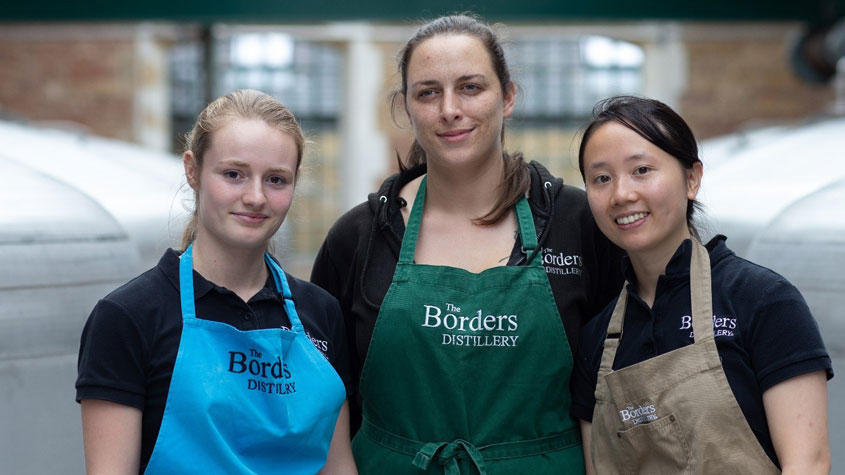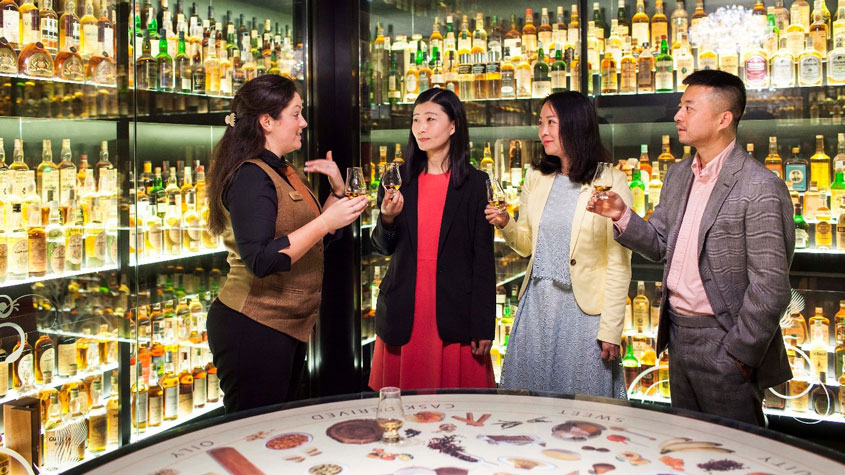
Scotch Whisky Sees IP, Diversity and Inclusion as Keys To its Longer-term Sustainability
By Catherine Jewell, Information and Digital Outreach Division, WIPO
Scotch Whisky is a hallmark of Scotland's national heritage and identity. Exported to around 180 markets, Scotch Whisky is an important part of the Scottish and UK economies, generating billions in exports and supporting thousands of jobs. The quality and reputation of Scotch Whisky has made it one of the world’s best-known geographical indications (GIs). Securing the long-term sustainability of this thriving industry is the task of the industry’s trade body, the Scotch Whisky Association (SWA). Caitlin O’Donnell, Senior Legal Counsel, and Kirsty Summers, Head of Workforce and Skills, explain what the SWA is doing to ensure the industry continues to thrive. In particular, they discuss the vital role that Scotch Whisky’s long-held GI status plays in ensuring consumers continue to enjoy genuine Scotch Whisky. They also highlight SWA’s efforts to secure access to the talent and skills the industry needs to continue to thrive, for example, through its Diversity and Inclusivity Charter.

Tell us about SWA’s role with the Scotch Whisky sector?
The Scotch Whisky Association is the trade body for the Scotch Whisky industry. Our role is to advance the global interests and profile of Scotch Whisky, our members and the industry as a whole. Our current membership includes distillers, bottlers, brand owners and brokers of Scotch Whisky. Together, they produce around 95% of the Scotch Whisky sold worldwide.
Our mission is to secure a sustainable future for the Scotch Whisky industry. We want Scotch Whisky to be produced sustainably, traded globally and enjoyed responsibly. To support that mission, we work hard to build strong relationships with all levels of government and opinion-formers and strive to:
- be a trusted voice in the debate on alcohol and society;
- support a competitive, sustainable and fairly taxed industry;
- safeguard the Scotch Whisky category and its reputation; and
- ensure fair access to all markets worldwide.
Tell us about Scotch Whisky and how it is protected.
Scotch Whisky is a geographical indication, meaning it can only be produced in Scotland in accordance with United Kingdom laws, which, among other things, require that Scotch Whisky is made from just three natural ingredients (cereals, water and yeast); matured for at least three years in oak casks; and has no added flavorings or sweeteners. Crucially, Scotch Whisky must also be produced in accordance with traditional practices. Indeed, traditionality is synonymous with the industry and the global reputation of Scotch Whisky as the world’s premier spirit drink, a reputation that has been built over many decades, aided by strong legal protection.
Traditionality is synonymous with the industry and the global reputation of Scotch Whisky as the world’s premier spirit drink.
The SWA Legal Affairs Team of five lawyers and two paralegals, protects Scotch Whisky from unscrupulous businesses who try to cash in on its success and reputation in a variety of ways. Issues range from passing off drinks as Scotch Whisky when they are not, to more subtle attempts to dress up products to look like Scotch, without using the GI, “Scotch Whisky.” Words such as “GLEN,” “HIGHLAND” and “SCOT” as well as tartan patterns, pipers and Scottish castles are commonly used by businesses to deceive consumers into thinking their products are Scotch Whisky when they are not. As well as depriving the industry of income, unfair competition - including the sale of fake “Scotch Whisky” - hurts consumers.

Our policy is to obtain GI protection for Scotch Whisky where ever we can. While different jurisdictions have different systems, Scotch Whisky is registered as a GI in over 70 countries. It is also registered as a certification trademark (e.g. in Australia and the USA) and as a collective trademark (e.g. in China). Even where Scotch Whisky has no specific protection, we can use the laws of passing-off and unfair competition to take action.
What challenges does the SWA face in maintaining Scotch Whisky’s GI status?
As exports of Scotch Whisky increase, so too do imitation products. This is one of our biggest challenges as it means that the scale of the SWA’s legal work is immense. While member companies will take action if their own brands are infringed, it is the SWA legal affairs team’s job to ensure the Scotch Whisky’s GI status is protected. We have a zero-tolerance approach to fake “Scotch Whisky.” When we learn of an imitation on sale, anywhere in the world, we seek to have that product removed from the market. Such action helps ensure that the reputation of Scotch Whisky, which has been built up over the years, is not eroded.
We have a zero-tolerance approach to fake "Scotch Whisky".
Thankfully, the industry has always prioritized protecting the reputation of Scotch Whisky as a Scottish product. This means that no court has yet refused to recognize Scotch Whisky as meaning whisky produced in Scotland. We hope to keep it that way.
What prompted SWA to embrace inclusion and diversity?
The industry as a whole started to prioritize diversity and inclusion in 2018. This work culminated in the launch of our Diversity and Inclusivity Charter in 2020.
The Charter seeks to ensure equal opportunities for all employees in the whisky industry regardless of gender, ethnicity, disability, age or sexual orientation. It establishes a clear path for all members to recognize and protect the diversity of their workforce.
By definition, Scotch Whisky is a traditional product. Skills and processes developed in Scotland and handed down over the centuries, including those of distillers, blenders and coopers, have a significant effect on the quality and character of Scotch Whisky. While these traditional crafts continue to play a vital role in the industry, other skills are equally crucial, from engineering, marketing and tourism through to green skills roles, which are increasingly significant. The industry needs a sustainable talent pool to maintain these skills. The industry acknowledges that sustainable recruitment means reaching the broadest possible group of people.
Skills and processes developed in Scotland and handed down over the centuries, […] have a significant effect on the quality and character of Scotch Whisky.

Tell us more about SWA's diversity journey
Our Charter was championed by our former CEO, Karen Betts. She was passionate about achieving a more diverse and inclusive global workforce for the industry. The aim in developing the Charter was to foster collaboration among our member companies, to learn from others’ experiences and to underscore our commitment to attracting a wide range of people to the industry in Scotland, and around the world, at all levels and at all stages of their careers.
Since 2020, perspectives on diversity and inclusion have rapidly evolved. Global movements like #MeToo and BlackLivesMatter have brought these issues into the limelight reminding us why they are so critical in our workplaces.
From the outset, we viewed the Charter as a living document that keeps pace with the world around us. Indeed, we are currently updating it to ensure it remains fit for purpose with the ongoing support of our current CEO, Mark Kent. The refreshed Charter, to be launched soon, stays true to its original goals and aligns with the SWA’s 2023 – 2025 strategy. Our aim is to encourage as many members as possible to sign up to the Charter, irrespective of where they are in their inclusion and diversity journey.
What are the economic arguments for inclusion and diversity within the industry?
Scotch Whisky is a core part of Scotland's national identity and heritage, and a fundamental part of the Scottish and UK economies. Scotch Whisky is exported to around 180 markets and, in 2022, the value of Scotch Whisky exports surpassed GBP 6 billion for the first time. The industry supports more than 11,000 people in a huge diversity of jobs throughout Scotland. Around 7,000 of these jobs are in rural areas, providing vital employment and investment to those communities. Further, the industry supports around 42,000 jobs across the UK through the supply chain. When you consider the number of people involved in the wider industry, including those in members’ partner organizations in cereals, haulage and so on, the significance of the impact that the SWA is making through its commitment to inclusion and diversity increases.
Scotch Whisky is exported to around 180 markets and, in 2022, the value of Scotch Whisky exports surpassed GBP 6 billion for the first time.
Tell us more about SWA’s commitment to inclusion and diversity?
The refresh of the Diversity and Inclusivity Charter sets out simple but powerful measures that signatories can work towards. These include encouraging senior executive teams to embrace inclusion and diversity and to develop action plans to implement measurable goals that support their business goals.
While measuring the impact of these plans remains arbitrary at this stage, the overarching goal is to position the Scotch Whisky sector as a provider of exciting careers, leveraging the potential of all people and better reflecting the communities it operates in.

What is the make-up of the industry in terms of gender?
We have experimented with data capture surveys, but haven’t yet nailed down how to get a true picture of the gender split within the industry. Inclusion and diversity, remains a fairly new business area and while we are confident that the workforce is split relatively equally between men and women, a robust analysis of the representation of women in whisky-specific or leadership roles is less clear. That is why we continue to encourage our members to contribute regularly to data collection surveys.
The loss of skills and knowledge through attrition or retirement and a lack of relevant skills coming through the education system are particular concerns.
However, we can make informed assumptions about the representation of women in leadership positions. These remain disproportionately low. That is why in 2023 the SWA is exploring ways to encourage women to take up leadership positions and to support those women who are already in such positions.
What are the implications of this for the sustainability of the sector?
The loss of skills and knowledge through attrition or retirement and a lack of relevant skills coming through the education system are particular concerns. Increasing focus on inclusion and diversity, which by its nature opens up the market, will help address these concerns and will create and/or increase the number of exciting career avenues for women.
Are your members open to inclusion and diversity?
SWA members support inclusion and diversity. But as in many sectors, we need to support employers who face difficulties in implementing related activities and goals. These challenges can range from the absence of a potential talent pool, for example, because of a remote location or small local community, to well-established teams made up almost exclusively of men, which is often simply a result of legacy. In these and similar cases, the challenge is to help members aspire to the Charter's goals while reassuring them that they are not going to be held to account for any perceived non-compliance.
SWA members support inclusion and diversity. But as in many sectors, we need to support employers who face difficulties in implementing related activities and goals.
One of the major challenges is how to increase the number of women who sit on the SWA’s Council, which is predominantly male. Addressing this situation would create an opportunity for SWA to lead by example. Similarly, the number of committees and working groups, which support the Council's work, provide an excellent development ground for women to engage in our work. Unfortunately, the current make-up of these groups gives the impression that women are unrepresented across the industry. This is not necessarily the case.
What can your members do to ensure women’s voices are heard within the industry?
Women are capable and ambitious and excel when conditions actively support their progression. There is a groundswell of positive action to help amplify women's voices, particularly in the skills space. Creative recruitment, apprenticeships and robust learning and development programs help women enter the industry and develop their skills. The challenge is that men’s voices, due to long careers and sheer passion for the industry, continue to be strong.
There is much that employers can do to implement “women-friendly” conditions.
There is much that employers can do to implement “women-friendly” conditions. Ensuring a focus on inclusion and diversity at all levels in a business will help increase awareness and support for women. Women often relish the opportunity to work flexible or hybrid patterns. So, it’s important that employers prioritize flexibility and employee wellbeing in addition to inclusion and diversity. It would be incredibly helpful if men also took advantage of these measures to ensure they are not seen purely as “things for women”. It is vital that we recruit and retain women in our sector and maintain an engaged workforce, representative of wider society.
The WIPO Magazine is intended to help broaden public understanding of intellectual property and of WIPO’s work, and is not an official document of WIPO. The designations employed and the presentation of material throughout this publication do not imply the expression of any opinion whatsoever on the part of WIPO concerning the legal status of any country, territory or area or of its authorities, or concerning the delimitation of its frontiers or boundaries. This publication is not intended to reflect the views of the Member States or the WIPO Secretariat. The mention of specific companies or products of manufacturers does not imply that they are endorsed or recommended by WIPO in preference to others of a similar nature that are not mentioned.